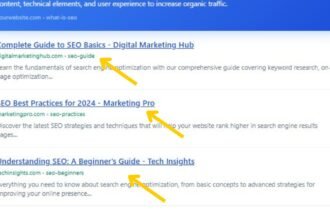If you’re still thinking about searching, the way you did in 2018 — keywords, backlinks, meta tags, and praying to the Google gods for traffic, I’ve got news for you. The rules have changed. And fast.
So, what is Generative Engine Optimization? In short, it’s the answer to how we survive and thrive in this new era of AI-powered search.
Forget the old-school SEO playbook. The search engines of today aren’t engines at all — they’re intelligent systems. ChatGPT, Gemini, Perplexity, and Google’s Search Generative Experience (SGE) aren’t showing users a list of links. They’re answering questions directly. They’re summarizing, citing, and synthesizing — often without the user ever clicking through to your website.
In fact, over 70% of search interactions in 2025 now involve AI-driven answers instead of traditional search results (source: Walker Sands, 2025). ChatGPT alone has surpassed Bing in daily search volume. And Google’s SGE is rapidly integrating AI responses into its core search experience. That means the competition isn’t just about who ranks #1 on Google anymore — it’s about whose content gets surfaced by AI when users ask.
This shift is seismic for marketers, business owners, content strategists, and SEO professionals. If your content isn’t optimized to be picked up, cited, or used by these AI engines, your audience may never see it no matter how brilliant your blog or how perfect your on-page SEO.
That’s why understanding what is Generative Engine Optimization matters now more than ever. It’s not just a buzzword. It’s how you keep your brand, your insights, and your expertise visible in an AI-driven search world.
In this publication, I’ll walk you through exactly what Generative Engine Optimization (GEO) is, why it’s different from traditional SEO, and how you can future-proof your content to ensure it’s not just found — it’s favored by the machines shaping the future of search.
What is Generative Engine Optimization?
Let’s get right to it: What is Generative Engine Optimization?
Generative Engine Optimization (often shortened to GEO) is the strategic process of crafting, structuring, and optimizing your content so that it becomes the preferred source for AI-driven search engines like ChatGPT, Gemini, Perplexity, and Google’s Search Generative Experience (SGE).
Instead of optimizing for clicks and search rankings like traditional SEO, Generative Engine Optimization focuses on visibility within AI-generated answers — those conversational, summarized responses AI tools now deliver straight to users. These engines are not pulling from a ranked list of links; they are scanning vast datasets, analyzing authority, context, and clarity, and generating direct, synthesized answers… often citing or mentioning brands, experts, and content that fit their AI models’ trust criteria.
How It Works in Practical
Traditional SEO says: “Get me on Page 1.”
GEO says: “Get me in the AI’s answer.”
Here’s how that plays out in real life:
A user asks ChatGPT, Gemini, or Perplexity, “What’s the best strategy for AI-driven content marketing in 2025?” The AI isn’t ranking websites. It’s generating a synthesized answer based on trusted, authoritative, well-optimized sources. If your brand, your article, your thought leadership piece is structured for GEO, your name is more likely to appear in that AI’s answer.
AI search platforms prioritize:
- Authority (E-E-A-T: Experience, Expertise, Authoritativeness, Trustworthiness)
- Contextual Relevance
- Clear, Conversational Language
- Entities and Semantic Signals
If you’re asking, “What is Generative Engine Optimization’s true purpose?” — it’s to make sure your content is the type AI engines love to surface, cite, and share in this new search landscape.
The Platforms Driving GEO Forward
The following AI search engines are actively changing the game for content visibility:
- ChatGPT (OpenAI / Microsoft)
- Gemini (Google AI)
- Perplexity AI
- Google SGE (Search Generative Experience)
These platforms are fundamentally different from traditional search engines. They don’t serve search results; they serve answers. And those answers rely on highly optimized, highly authoritative content.
Why the Shift Matters
“AI engines are already responsible for shaping more than 60-70% of online discovery interactions in 2025, a number growing by the quarter.” — Digital Strike, 2025
If you’re wondering why your competitors seem to show up more frequently in AI answers while your traffic is stagnant, this is likely why:
They’ve embraced Generative Engine Optimization — you haven’t.
Why Generative Engine Optimization Matters in 2025 (with Data)

If you’re still asking, “What is Generative Engine Optimization, and why should I care?” this is where the real-world impact becomes impossible to ignore.
Generative Engine Optimization isn’t just another passing marketing trend. It’s already reshaping how information is found, consumed, and trusted online. The way people search and how AI delivers answers has shifted dramatically.
The Data Doesn’t Lie
Here’s what’s happening right now in 2025:
- 71% of users now rely on AI-powered tools like ChatGPT, Gemini, and Perplexity for search and answers before consulting traditional search engines.
- ChatGPT’s search volume surpassed Bing’s daily active users in Q2 2025, becoming the second-largest “search engine” after Google’s AI-integrated platforms.
- Google’s Search Generative Experience (SGE) is live in over 120 countries, altering how billions access information favoring AI-generated summaries over traditional blue links.
These aren’t fringe platforms anymore. These are the primary gateways for digital discovery.
Why AI Search Changes Everything for Visibility
AI-driven search isn’t about ranking #1 anymore. It’s about being the answer.
Traditional SEO focused on getting people to click. GEO focuses on getting AI to pick your content as the most authoritative, reliable, and relevant for a particular topic.
Think of it this way:
- In traditional SEO, visibility = page rank.
- In Generative Engine Optimization, visibility = inclusion in AI answers, citations, and summaries.
When users ask “What is Generative Engine Optimization?” on platforms like ChatGPT, Gemini, or Perplexity, these AI engines aren’t pulling from just one source. They aggregate multiple trusted, authoritative voices. If your brand isn’t optimized for this — through contextual relevance, entity recognition, and content authority — you’re invisible.
How This Impacts Marketers, Brands, and Content Creators
If your business, your blog, or your brand isn’t preparing for this shift, here’s what’s at stake:
- Less organic traffic from traditional search engines.
- Fewer opportunities for brand visibility via AI-driven answers.
- Falling behind competitors already adapting to this future.
On the flip side, those who understand what is Generative Engine Optimization and apply its principles gain:
- First-mover advantage in AI-powered search landscapes.
- Increased brand authority through AI citations and mentions.
- A future-proof content strategy aligned with evolving user behavior.
GEO is Visibility 2.0 — Miss It, and You’ll Miss Out
The shift is already happening. AI doesn’t reward the loudest voice, it rewards the most authoritative, contextually relevant, and clearly communicated content. GEO is how you position your content to meet those expectations.
Core Differences Between Traditional SEO and Generative Engine Optimization
By now, it’s clear that Generative Engine Optimization isn’t just a buzzword, it’s a necessary evolution. But to fully grasp its impact, you need to understand how it fundamentally differs from traditional SEO. These aren’t minor tweaks. These are deep shifts in how content is discovered, processed, and served to audiences.
So, what is Generative Engine Optimization compared to the SEO you’re used to? Let’s break it down:
Traditional SEO vs. Generative Engine Optimization (GEO)
| Aspect | Traditional SEO | Generative Engine Optimization (GEO) |
| Primary Goal | Rank high on Search Engine Results Pages (SERPs) | Appear in AI-generated answers, summaries, citations |
| Optimization Focus | Keywords, backlinks, meta descriptions | Authority, expertise (E-E-A-T), semantic relevance, entities |
| User Journey | Click through to read content | Receives answer directly from AI, often with cited sources |
| Content Structure | Keyword-heavy, meta tag optimized | Conversational, natural language, question-based, topic clusters |
| Measurement Metrics | Traffic, CTR, bounce rate | Mentions in AI outputs, citation frequency, brand visibility in AI |
| Search Tools | Google, Bing, Yahoo | ChatGPT, Gemini, Perplexity, Google SGE, Anthropic’s Claude |
The Philosophical Shift: From Keywords to Context
Traditional SEO taught us to reverse-engineer Google’s algorithms: focus on keywords, page speed, backlinks. Optimize to climb the ladder.
Generative Engine Optimization demands we think like AI: focus on depth, clarity, and authority. Optimize so AI trusts you enough to quote you.
Instead of asking:
“How do I get more clicks from search results?”
GEO asks:
“How do I become the source AI trusts to answer this question?”
Why This Shift Feels Bigger Than SEO’s Past Changes
Remember when Google’s algorithm updates forced us to pivot toward quality content and away from keyword stuffing? GEO is that shift—on steroids.
AI platforms aren’t reading your meta tags. They’re understanding your content, your authority, your context. They’re recognizing patterns:
- Does this brand consistently deliver trustworthy insights?
- Is this article comprehensive and structured in a human-like, conversational flow?
- Are entities, concepts, and contexts clearly defined and connected?
The better your content answers these unspoken AI questions, the more visible you become.
Why You Can’t Ignore This
Failing to adapt your strategy to what is Generative Engine Optimization isn’t just about losing traffic. It’s about losing visibility entirely in the spaces where your audience is now searching for answers.
Think about it:
- Traditional SEO = Page 1 visibility
- GEO = Answer box visibility, AI-generated conversation visibility, thought leadership recognition
And in 2025, more people trust answers from AI than the list of links beneath them.
5 Steps on How to Optimize for Generative Engines
Now that we’ve answered what is Generative Engine Optimization, let’s get practical. This is where you turn insight into action. Traditional SEO strategies won’t disappear entirely, but they need to evolve—radically—if you want your content to appear in AI-generated answers from platforms like ChatGPT, Gemini, Perplexity, and Google SGE.
Below is your step-by-step framework for mastering Generative Engine Optimization and ensuring your content is AI-visible, AI-citable, and AI-trusted.
Step 1: Write for Intent, Not Just Keywords
Stop obsessing over keyword stuffing. AI engines don’t rank content on density, they prioritize contextual accuracy and intent alignment.
Think audience first, question second, keyword third.
Ask yourself:
- What problems is my audience trying to solve?
- How are they phrasing these questions in natural language?
- Does my content offer a complete, clear, and authoritative answer?
Use LSI and NLP keywords naturally throughout:
- AI-powered search
- Natural language search
- Conversational content
- Question answering
Step 2: Structure Content with Topic Clusters & Conversational Language
AI loves structured content. Create pillar pages supported by cluster topics that answer related questions. This signals authority and depth within a subject.
Organize your content like this:
- Core Pillar: What is Generative Engine Optimization?
- Supporting Clusters:
- Benefits of GEO
- GEO vs. SEO
- Tools for Generative Optimization
- Common Mistakes in GEO
Use natural, question-based headings. Write as if you’re answering a curious, intelligent human—not gaming an algorithm.
Step 3: Prioritize Authority, Credibility & E-E-A-T
Generative engines evaluate your content through the lens of E-E-A-T (Experience, Expertise, Authoritativeness, Trustworthiness).
Cite credible sources. Reference trusted studies and statistics. Include expert quotes when possible.
Questions AI engines “ask” when crawling your content:
- Is this written by a legitimate expert?
- Does this source consistently provide value?
- Is this information backed up with data or reputable citations?
Use terms like:
- Content authority
- Source attribution
- Brand mention optimization
Step 4: Optimize for Entities, Context & Semantic Search
AI doesn’t just read words—it understands entities (people, places, brands, topics) and how they relate.
Strengthen your content’s semantic signals:
- Include related entities (e.g., ChatGPT, Google SGE, LLMs).
- Connect concepts clearly.
- Use synonyms and context-building phrases naturally:
- Search intent
- Semantic search
- Keyword clusters
Implement schema markup where possible to make your content machine-readable.
Step 5: Monitor AI Search Performance & Iterate
This isn’t set-it-and-forget-it. Track how AI platforms cite, reference, or summarize your content. New tools are emerging specifically for Generative Engine Optimization monitoring, such as:
- Perplexity AI Reporting
- SGE Analytics
- Brand mention monitoring tools
Watch for:
- Citation frequency in AI answers
- Brand visibility in AI summaries
- Shifts in branded search patterns
Iterate your strategy based on what content AI platforms reward most consistently.
Recap: What Is Generative Engine Optimization Really About?
It’s about positioning your content not for search engine bots, but for AI systems actively shaping user answers in real-time.
It’s about context, authority, and clarity—delivered in a human-like, conversational, and authoritative tone.
LSI & NLP Keywords to Embed for Maximum Visibility
If you want to succeed with Generative Engine Optimization, you can’t afford to overlook the semantic depth of your content. AI-driven engines like ChatGPT, Gemini, Perplexity, and Google SGE don’t just scan for primary keywords. They look for contextual signals—the supporting vocabulary, entities, and related terms that help clarify your authority on a topic.
That’s where LSI (Latent Semantic Indexing) and NLP (Natural Language Processing) keywords come in. These keywords aren’t just filler; they strengthen your relevance, help AI understand your expertise, and position your content as a reliable source.
Let’s look at the keyword: GEO. Hence, below is a curated and example list of LSI and NLP keywords that you should naturally integrate.
Primary LSI & NLP Keywords for GEO Success
| Category | Suggested Keywords |
| AI & Search Technologies | AI search optimization, Generative AI SEO, Large language models (LLMs), AI-powered search, Natural language search, Conversational AI, AI-generated answers |
| Search Behavior & Intent | Search intent, Semantic search, Contextual keywords, Keyword clusters, Long-tail keywords, Question answering, User journey optimization |
| Authority & Trust Signals | Content authority, Source attribution, Brand mention optimization, Digital credibility, Trustworthiness signals, Expertise markers (E-E-A-T) |
| Technical Optimization | Entity optimization, Schema markup, Structured data, Semantic signals, Search engine crawling, Topic clusters |
| Content Strategy | Conversational content, Question-led headings, Thought leadership content, AI visibility strategies, Comprehensive answers, Context-rich writing |
How to Use These LSI/NLP Keywords Effectively
Spread them naturally throughout your content—avoid stuffing. Prioritize flow, clarity, and readability.
Integrate into headings, subheadings, and bullet points where appropriate.
Use them contextually to support your core messaging:
Instead of writing:
“What is Generative Engine Optimization? It’s a new SEO method…”
Write:
“What is Generative Engine Optimization? It’s a strategy aligned with AI-powered search, semantic search, and the evolving expectations of conversational AI platforms.”
Ensure your content reflects how users naturally search—with questions, conversational tone, and intent-focused phrasing.
Why These Keywords Matter to AI
AI doesn’t operate on surface-level connections. It builds semantic maps of ideas, topics, and related entities. Using these LSI/NLP keywords signals to AI platforms that your content is:
- Comprehensive
- Contextually aware
- Relevant to the broader conversation on Generative Engine Optimization
The more aligned your language is with the way AI understands these concepts, the more likely your content will be surfaced, cited, and trusted.
How To Avoid Mistakes with Generative Engine Optimization
Now that you understand what is Generative Engine Optimization and how to apply it, let’s make sure you’re not falling into the common traps that keep brands invisible to AI engines like ChatGPT, Gemini, Perplexity, and Google SGE.
GEO isn’t about hacking a system it’s about aligning with how AI platforms process and serve information. Missteps here don’t just reduce visibility… they can erase you entirely from AI-generated answers.
Top 5 Mistakes Brands Make with GEO (And How to Avoid Them)
1. Treating GEO Like Traditional SEO
You can’t simply slap a few AI-related keywords into your old blog posts and expect ChatGPT to notice. GEO is about intent, depth, and relevance, not keyword density.
Fix: Prioritize conversational, authoritative, entity-rich content that solves specific user queries in full.
2. Ignoring E-E-A-T Principles
AI engines evaluate your Experience, Expertise, Authoritativeness, and Trustworthiness (E-E-A-T). If your content lacks citations, credible backing, or proof of expertise, it won’t be cited—period.
Fix: Back up claims with reputable sources, data, and clear author credentials.
3. Writing in Keyword-Stuffed, Robotic Language
AI platforms favor content that sounds like a human wrote it for other humans. Over-optimized, unnatural writing won’t make the cut.
Fix: Adopt a natural, conversational tone. Answer questions clearly. Use LSI and NLP keywords organically.
4. Overlooking Entity Optimization
AI engines understand content through entities and relationships. Neglecting to mention related topics, tools, or brands weakens your authority.
Fix: Integrate key entities (ChatGPT, LLMs, Google SGE, Perplexity, etc.) and related concepts to reinforce your authority in the space.
5. Failing to Monitor AI Visibility
If you aren’t tracking how AI engines are referencing your content, you won’t know what’s working. GEO isn’t set-and-forget—it’s ongoing optimization.
Fix: Use emerging AI visibility tools to monitor mentions, citations, and performance across platforms.
Summary of Mistakes to Avoid:
| Mistake | Consequence | Correction |
| Treating GEO like old SEO | AI won’t prioritize your content | Focus on authority, entities, clarity |
| Ignoring E-E-A-T | Reduced trust, fewer citations | Demonstrate expertise & credibility |
| Robotic, keyword-stuffed writing | Poor AI comprehension | Write conversational, natural content |
| Missing entity connections | Weak relevance signals | Optimize with related entities |
| Not tracking performance | Missed opportunities, blind spots | Monitor AI visibility actively |
The Future of Search: Why Generative Engine Optimization is Non-Negotiable
If you’ve stuck with me this far, you already understand what is Generative Engine Optimization and how to leverage it. But here’s the bigger picture: GEO isn’t just a tactic it’s the future foundation of how people will find, trust, and interact with information online.
Traditional search isn’t dying overnight, but it’s evolving fast. AI-powered engines like ChatGPT, Gemini, Perplexity, and Google SGE are changing the expectations of users and the rules of digital visibility. The question is no longer:
“How do I rank higher?”
It’s:
“How do I ensure my content is the trusted answer AI platforms choose to share?”
The Direction Search Is Headed
AI-First Discovery
More users are skipping search engines entirely, turning to AI chatbots for faster, more contextual answers. That behavior is only accelerating.
Answers Over Clicks
Clicks won’t matter if no one sees the link. AI engines surface answers, summaries, and citations—not blue links buried beneath ads.
Authority Becomes Exponential
The brands, experts, and websites AI trusts today will become the authoritative voices users trust tomorrow. Early movers will dominate visibility across AI channels.
Search Fragmentation Will Explode
It’s not just about Google anymore. AI search is splintering into dozens of platforms, all with unique algorithms: ChatGPT, Gemini, Perplexity, Anthropic’s Claude, and more. Your strategy needs to cover all of them.
Why GEO Is Your Competitive Edge Now
Brands that understand Generative Engine Optimization now will:
- Win visibility in AI-driven answers.
- Build digital authority across fragmented search ecosystems.
- Future-proof their content strategies for the next decade.
- Outrank, outperform, and outlast competitors still clinging to outdated SEO mindsets.
Those who don’t?
They’ll find themselves invisible to the platforms where users are already searching.
Final Takeaway: The Future Belongs to the Visible, the Authoritative, and the Prepared
The brands that lead with clarity, authority, and relevance will dominate the AI search landscape. GEO isn’t optional—it’s essential.
If you’re still wondering what is Generative Engine Optimization in 2025, the answer is simple:
It’s how your content stays seen, cited, and trusted—by both AI and humans.
Recap & Actionable Next Steps to Master Generative Engine Optimization
Let’s bring it all together. You came here asking: What is Generative Engine Optimization? Now, you’ve got the answer—and the roadmap to put it into action.
Here’s your quick-fire recap of what you need to remember moving forward:
What is Generative Engine Optimization?
It’s the strategic process of optimizing your content to ensure it’s recognized, trusted, and cited by AI-driven search platforms like ChatGPT, Gemini, Perplexity, and Google SGE.
Unlike traditional SEO, GEO isn’t focused on ranking web pages it’s focused on being the answer AI platforms choose to share.
5 Core Pillars of GEO Success
- Write for Intent, Not Just Keywords
Answer the real questions your audience is asking. - Use Topic Clusters & Conversational Language
Structure content around related, natural-language questions and clear answers. - Prioritize Authority (E-E-A-T)
Establish expertise, cite credible sources, and demonstrate trustworthiness. - Optimize Entities & Context
Strengthen connections between topics, concepts, and related entities through smart, semantic writing. - Monitor & Iterate
Track your AI citations, mentions, and visibility—and refine continuously.
Avoid These Common Mistakes
- Don’t treat GEO like traditional SEO.
- Don’t write robotic, keyword-stuffed content.
- Don’t ignore E-E-A-T and entity optimization.
- Don’t neglect to monitor AI search performance.
5 Steps You Need To Take:
- Audit Your Existing Content:
Identify gaps where your current content fails to meet GEO principles. - Create AI-Optimized Content:
Start producing content specifically structured for conversational, AI-powered search—clear answers, authority, and depth. - Implement Topic Clusters:
Organize content around pillars and clusters that naturally answer related questions. - Leverage Schema & Structured Data:
Make your content machine-readable and context-rich. - Track Your Visibility:
Monitor AI search engines for citations, mentions, and trends tied to your brand and content.
Conclusion: Adapt Now, or Get Left Behind
If you’ve made it this far, you already know what is Generative Engine Optimization—but knowing isn’t enough. In 2025 and beyond, GEO is the new competitive battleground for online visibility. This isn’t theory. This is already how AI-powered search engines are deciding who gets seen, cited, and trusted… and who disappears.
The Hard Truth:
Traditional SEO alone won’t keep you relevant. If your content isn’t optimized for AI-driven discovery, you’re not part of the conversation anymore.
The winners in this new landscape?
- The brands adapting faster.
- The businesses optimizing smarter.
- The creators building trust through clarity, authority, and expertise.
If your content isn’t prepared to answer questions like “What is Generative Engine Optimization?” across AI platforms, your competitors’ content will be.
Key Takeaway:
Generative Engine Optimization is not optional. It’s survival.
It’s about securing your place at the AI-powered table, ensuring your expertise is recognized, and future-proofing your visibility.
The future of search isn’t coming. It’s already here. The question is:
Will AI find your answer… or someone else’s?
Frequently Asked Questions on Generative Engine Optimization
Here’s a ready-to-use FAQ section to complement your blog on What is Generative Engine Optimization? This will help reinforce key points, satisfy search intent, and improve AI search visibility through natural question-answer formats.
What is Generative Engine Optimization in simple terms?
Generative Engine Optimization (GEO) is the process of optimizing content so that it gets picked up, cited, or summarized by AI-powered search platforms like ChatGPT, Gemini, Perplexity, and Google SGE. Unlike traditional SEO, which focuses on ranking pages, GEO focuses on appearing in AI-generated answers.
How is Generative Engine Optimization different from SEO?
Traditional SEO helps your website rank on search engine result pages (SERPs) through keywords, backlinks, and technical optimization. Generative Engine Optimization helps your content become the trusted source AI platforms use to answer user queries directly—without relying on traditional ranking signals.
Why is Generative Engine Optimization important in 2025?
With the rise of AI-powered search engines and generative AI platforms, users are increasingly getting direct answers instead of clicking links. GEO ensures your content remains visible and authoritative in these new AI-driven ecosystems.
What platforms use Generative Engine Optimization principles?
Platforms like ChatGPT, Gemini, Perplexity, Anthropic’s Claude, and Google’s Search Generative Experience (SGE) use generative engines to deliver answers, making GEO crucial for visibility on these channels.
How can I start optimizing for Generative Engines?
Start by creating content that answers user questions clearly, demonstrates authority (E-E-A-T), uses conversational language, leverages topic clusters, and integrates related entities. Monitor how AI platforms cite or mention your brand and refine your strategy over time.
Does GEO replace traditional SEO?
No. Traditional SEO and GEO complement each other. While SEO drives organic traffic via search rankings, GEO ensures your content is cited and surfaced by AI tools. Future-proof brands will use both strategies together.













